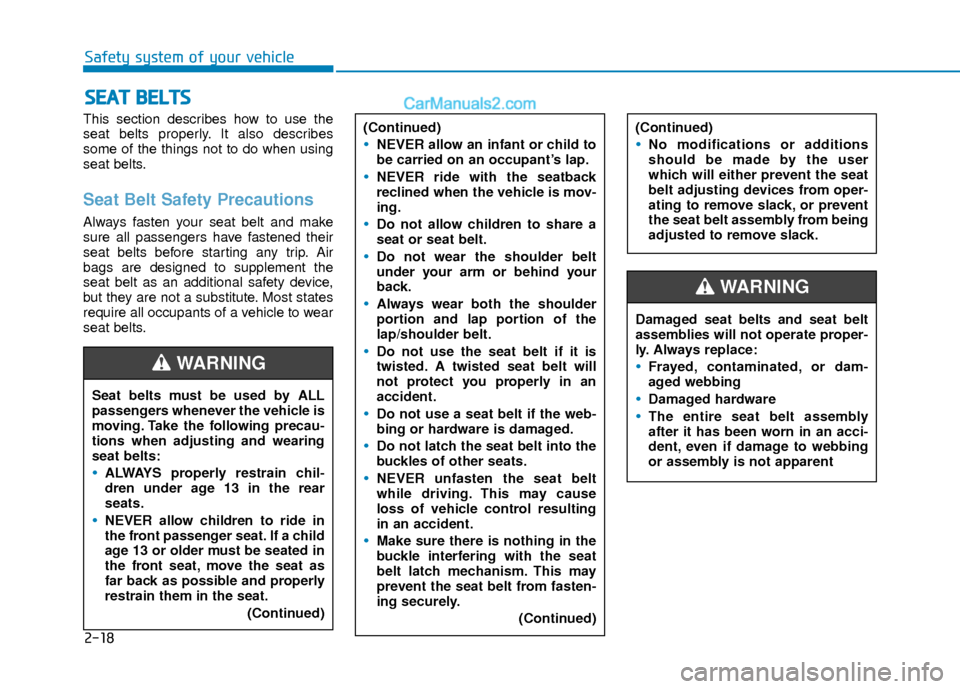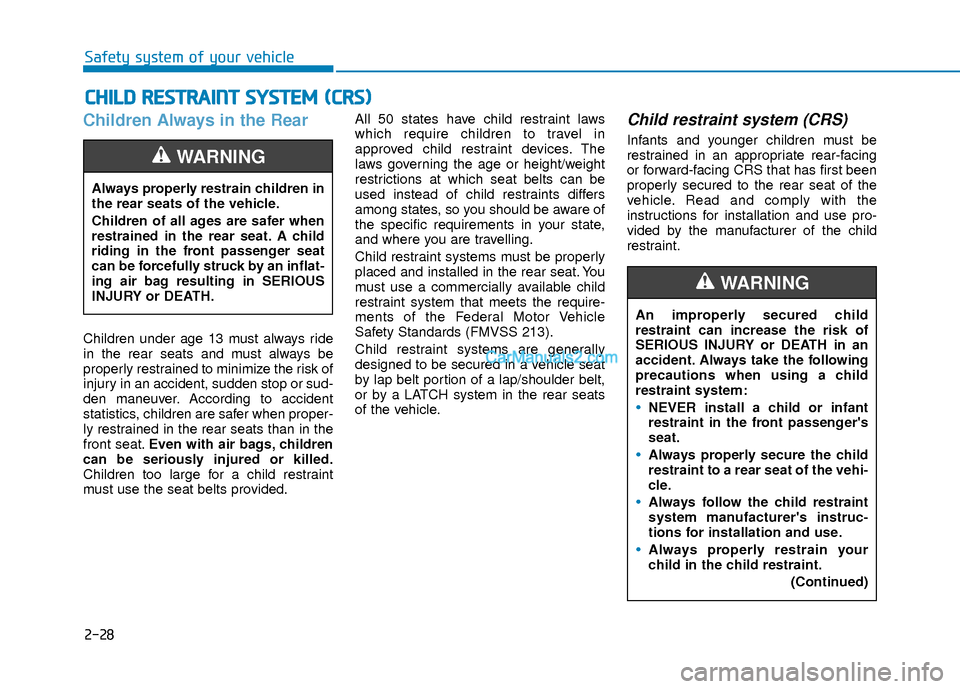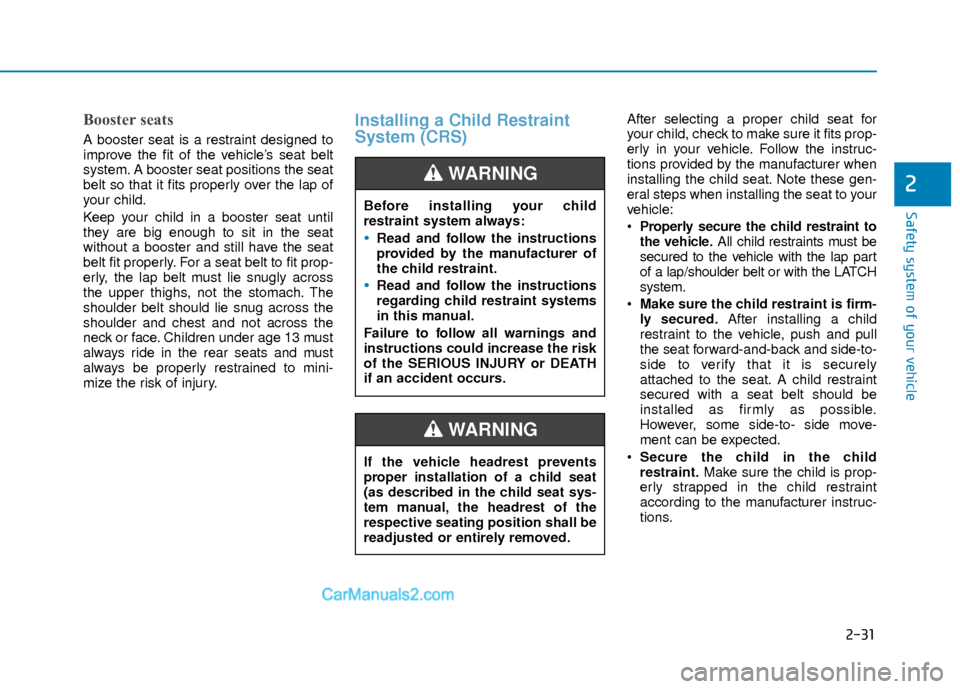2018 Hyundai Elantra ECU
[x] Cancel search: ECUPage 7 of 526

F7
Introduction
F
FU
U E
EL
L
R
R E
EQ
Q U
UI
IR
R E
EM
M E
EN
N T
TS
S
NOTICE indicates a situation which, if
not avoided, could result in vehicle
damage. Your new vehicle is designed to obtain
maximum performance with UNLEADED
FUEL, as well as minimize exhaust emis-
sions and spark plug fouling.
Your new vehicle is designed to use only
unleaded fuel having an octane number
((R+M)/2) of 87 (Research Octane
Number 91) or higher. (Do not use
methanol blended fuels)
To prevent damage to the engine and
engine components, never add any
fuel system cleaning agents to the
fuel tank other than what has been
specified.
Consult an authorized HYUNDAI deal-
er for additional information.
Gasoline containing alcohol or
methanol
Gasohol, a mixture of gasoline and
ethanol (also known as grain alcohol) are
being marketed along with or instead of
leaded or unleaded gasoline. For exam-
ple, "E15" is a gasohol comprised of 15%
ethanol and 85% gasoline.
Do not use gasohol containing more than
15% ethanol, and do not use gasoline or
gasohol containing any methanol. Either
of these fuels may cause drivability prob-
lems and damage to the fuel system,
engine control system and emission con-
trol system.
Discontinue using gasohol of any kind if
drivability problems occur.
NOTICE
NOTICE
CAUTION indicates a hazardous sit-
uation which, if not avoided, could
result in minor or moderate injury.
CAUTION
•Do not "top off" after the nozzle
automatically shuts off when
refueling.
Always check that the fuel cap is
installed securely to prevent fuel
spillage in the event of an acci-
dent.
WARNING
Page 28 of 526

2-11
Safety system of your vehicle
2
4. Fold the seatback toward the front ofthe vehicle.
5. To use the rear seat, lift and unfold the seatback to the upright position. Push
the seatback firmly until it clicks into
place. Make sure the seatback is
locked in place.
When you return the seatback to its upright position, always be sure it has
locked into position by pushing on the
top of the seatback.
OAD035022
Do not place objects in the rear
seats, since they cannot be proper-
ly secured and may hit vehicle
occupants in a collision causing
serious injury or death.
WARNING
When returning the rear seatback
from a folded to an upright posi-
tion, hold the seatback and return it
slowly. Ensure that the seatback is
completely locked into its upright
position by pushing on the top of
the seatback. In an accident or sud-
den stop, the unlocked seatback
could allow cargo to move forward
with great force and enter the pas-
senger compartment, which could
result in serious injury or death.
WARNING
Make sure the engine is off, the
shift lever is in P (Park), and the
parking brake is securely applied
whenever loading or unloading
cargo. Failure to take these steps
may allow the vehicle to move if the
shift lever is inadvertently moved to
another position.
WARNING
Page 29 of 526

2-12
Safety system of your vehicle
Armrest (if equipped)
The armrest is located in the center of
the rear seat. Pull the armrest down by
using the strap from the seatback to use
it.
If your car is not equipped with a rear
armrest, the rear cup holders are located
at the back of the center console.
Head Restraints
The vehicle's front and rear seats have
adjustable head restraints. The head
restraints provide comfort for passen-
gers, but more importantly they are
designed to help protect passengers
from whiplash and other neck and spinal
injuries during an accident, especially in
a rear impact collision.
OAD035023
Be careful when loading cargo
through the rear passenger seats
to prevent damage to the vehicle
interior.
When cargo is loaded through
the rear passenger seats, ensure
the cargo is properly secured to
prevent it from moving while driv-
ing.
Unsecured cargo in the passen-
ger compartment can cause dam-
age to the vehicle or injury to it's
occupants.
CAUTION
To reduce the risk of serious injury
or death in an accident, take the fol-
lowing precautions when adjusting
your head restraints:
Always properly adjust the head
restraints for all passengers
BEFORE starting the vehicle.
NEVER let anyone ride in a seat
with the head restraints removed.(Continued)
WARNING
Page 35 of 526

2-18
Safety system of your vehicle
This section describes how to use the
seat belts properly. It also describes
some of the things not to do when using
seat belts.
Seat Belt Safety Precautions
Always fasten your seat belt and make
sure all passengers have fastened their
seat belts before starting any trip. Air
bags are designed to supplement the
seat belt as an additional safety device,
but they are not a substitute. Most states
require all occupants of a vehicle to wear
seat belts.
S SE
E A
A T
T
B
B E
EL
LT
T S
S
Seat belts must be used by ALL
passengers whenever the vehicle is
moving. Take the following precau-
tions when adjusting and wearing
seat belts:
ALWAYS properly restrain chil-
dren under age 13 in the rear
seats.
NEVER allow children to ride in
the front passenger seat. If a child
age 13 or older must be seated in
the front seat, move the seat as
far back as possible and properly
restrain them in the seat.
(Continued)
WARNING
(Continued)
NEVER allow an infant or child to
be carried on an occupant’s lap.
NEVER ride with the seatback
reclined when the vehicle is mov-
ing.
Do not allow children to share a
seat or seat belt.
Do not wear the shoulder belt
under your arm or behind your
back.
Always wear both the shoulder
portion and lap portion of the
lap/shoulder belt.
Do not use the seat belt if it is
twisted. A twisted seat belt will
not protect you properly in an
accident.
Do not use a seat belt if the web-
bing or hardware is damaged.
Do not latch the seat belt into the
buckles of other seats.
NEVER unfasten the seat belt
while driving. This may cause
loss of vehicle control resulting
in an accident.
Make sure there is nothing in the
buckle interfering with the seat
belt latch mechanism. This may
prevent the seat belt from fasten-
ing securely.(Continued)
(Continued)
No modifications or additions
should be made by the user
which will either prevent the seat
belt adjusting devices from oper-
ating to remove slack, or prevent
the seat belt assembly from being
adjusted to remove slack.
Damaged seat belts and seat belt
assemblies will not operate proper-
ly. Always replace:
Frayed, contaminated, or dam-
aged webbing
Damaged hardware
The entire seat belt assembly
after it has been worn in an acci-
dent, even if damage to webbing
or assembly is not apparent
WARNING
Page 39 of 526

2-22
Safety system of your vehicle
Rear Seat Belt – Passenger's 3-point system with convertiblelocking retractor
This type of seat belt combines the fea-
tures of both an emergency locking
retractor seat belt and an automatic lock-
ing retractor seat belt. Convertible retrac-
tor type seat belts are installed in the rear
seat positions to help accommodate the
installation of child restraint systems.
Although a convertible retractor is also
installed in the front passenger seat posi-
tion, NEVER place any infant/child
restraint system in the front seat of the
vehicle.
To fasten your seat belt:
Pull the seat belt out of the retractor and
insert the metal tab into the buckle. There
will be an audible "click" when the tab
locks into the buckle. When not securing
a child restraint, the seat belt operates in
the same way as the driver's seat belt
(Emergency Locking Retractor Type). It
automatically adjusts to the proper length
only after the lap belt portion of the seat
belt is adjusted manually so that it fits
snugly across your hips. When the seat belt is fully extended from
the retractor to allow the installation of a
child restraint system, the seat belt oper-
ation changes to allow the belt to retract,
but not to extend (Automatic Locking
Retractor Type). Refer to the "Using a
Child Restraint System" section in this
chapter.
Although the seat belt retractor pro-
vides the same level of protection for
seated passengers in either emer-
gency or automatic locking modes,
the emergency locking mode allows
seated passengers to move freely in
their seat while keeping some tension
on the belt. During a collision or sud-
den stop, the retractor automatically
locks the belt to help restrain your
body.
To deactivate the automatic locking
mode, unbuckle the seat belt and
allow the belt to fully retract.
To release your seat belt:
Press the release button (1) in the lock-
ing buckle.
When it is released, the belt should auto-
matically draw back into the retractor. If
this does not happen, check the belt to
be sure it is not twisted, then try again.
NOTICE
ODH033057
Page 43 of 526

2-26
Safety system of your vehicle
Seat belt use and children
Infant and small children
All 50 states have child restraint laws
which require children to travel in
approved child restraint devices, includ-
ing booster seats. The age at which seat
belts can be used instead of child
restraints differs among states, so you
should be aware of the specific require-
ments in your state, and where you are
travelling. Infant and child restraints must
be properly placed and installed in a rear
seat. For more information refer to the
"Child Restraint Systems" section in this
chapter.Small children are best protected from
injury in an accident when properly
restrained in the rear seat by a child
restraint system that meets the require-
ments of the Federal Motor Vehicle
Safety Standards. Before buying any
child restraint system, make sure that it
has a label certifying that it meets
Federal Motor Vehicle Safety Standard
FMVSS 213. The restraint must be
appropriate for your child’s height and
weight. Check the label on the child
restraint for this information. Refer to the
"Child Restraint Systems" section in this
chapter.
Larger children
Children under age 13 and who are too
large for a booster seat must always
occupy the rear seat and use the avail-
able lap/shoulder belts. A seat belt
should lie across the upper thighs and be
snug across the shoulder and chest to
restrain the child safely. Check belt fit
periodically. Children are afforded the
most safety in the event of an accident
when they are restrained by a proper
restraint system and/or seat belts in the
rear seat. Always have the LATCH sys-
tem inspected by your authorized
HYUNDAI dealer after an accident. An
accident can damage the LATCH system
and may not properly secure the child
restraint.
If a larger child over age 13 must be seat-
ed in the front seat, the child must be
securely restrained by the available
lap/shoulder belt and the seat should be
placed in the rearmost position.
If the shoulder belt portion slightly touch-
es the child's neck or face, try placing the
child closer to the center of the vehicle. If
the shoulder belt still touches their face
or neck they need to be returned to an
appropriate booster seat in the rear seat.
ALWAYS properly restrain infants
and small children in a child
restraint appropriate for the child’s
height and weight.
To reduce the risk of serious injury
or death to a child and other pas-
sengers, NEVER hold a child in
your lap or arms when the vehicle
is moving. The violent forces creat-
ed during an accident will tear the
child from your arms and throw the
child against the interior of the
vehicle.
WARNING
Page 45 of 526

2-28
Safety system of your vehicle
Children Always in the Rear
Children under age 13 must always ride
in the rear seats and must always be
properly restrained to minimize the risk of
injury in an accident, sudden stop or sud-
den maneuver. According to accident
statistics, children are safer when proper-
ly restrained in the rear seats than in the
front seat.Even with air bags, children
can be seriously injured or killed.
Children too large for a child restraint
must use the seat belts provided. All 50 states have child restraint laws
which require children to travel in
approved child restraint devices. The
laws governing the age or height/weight
restrictions at which seat belts can be
used instead of child restraints differs
among states, so you should be aware of
the specific requirements in your state,
and where you are travelling.
Child restraint systems must be properly
placed and installed in the rear seat. You
must use a commercially available child
restraint system that meets the require-
ments of the Federal Motor Vehicle
Safety Standards (FMVSS 213).
Child restraint systems are generally
designed to be secured in a vehicle seat
by lap belt portion of a lap/shoulder belt,
or by a LATCH system in the rear seats
of the vehicle.
Child restraint system (CRS)
Infants and younger children must be
restrained in an appropriate rear-facing
or forward-facing CRS that has first been
properly secured to the rear seat of the
vehicle. Read and comply with the
instructions for installation and use pro-
vided by the manufacturer of the child
restraint.
C C
H
H I
IL
L D
D
R
R E
ES
ST
T R
R A
A I
IN
N T
T
S
S Y
Y S
ST
T E
EM
M
(
( C
C R
R S
S)
)
Always properly restrain children in
the rear seats of the vehicle.
Children of all ages are safer when
restrained in the rear seat. A child
riding in the front passenger seat
can be forcefully struck by an inflat-
ing air bag resulting in SERIOUS
INJURY or DEATH.
WARNING
An improperly secured child
restraint can increase the risk of
SERIOUS INJURY or DEATH in an
accident. Always take the following
precautions when using a child
restraint system:
NEVER install a child or infant
restraint in the front passenger's
seat.
Always properly secure the child
restraint to a rear seat of the vehi-
cle.
Always follow the child restraint
system manufacturer's instruc-
tions for installation and use.
Always properly restrain your
child in the child restraint.
(Continued)
WARNING
Page 48 of 526

2-31
Safety system of your vehicle
2
Booster seats
A booster seat is a restraint designed to
improve the fit of the vehicle’s seat belt
system. A booster seat positions the seat
belt so that it fits properly over the lap of
your child.
Keep your child in a booster seat until
they are big enough to sit in the seat
without a booster and still have the seat
belt fit properly. For a seat belt to fit prop-
erly, the lap belt must lie snugly across
the upper thighs, not the stomach. The
shoulder belt should lie snug across the
shoulder and chest and not across the
neck or face. Children under age 13 must
always ride in the rear seats and must
always be properly restrained to mini-
mize the risk of injury.
Installing a Child Restraint
System (CRS)After selecting a proper child seat for
your child, check to make sure it fits prop-
erly in your vehicle. Follow the instruc-
tions provided by the manufacturer when
installing the child seat. Note these gen-
eral steps when installing the seat to your
vehicle:
Properly secure the child restraint to
the vehicle.All child restraints must be
secured to the vehicle with the lap part
of a lap/shoulder belt or with the LATCH
system.
Make sure the child restraint is firm-
ly secured. After installing a child
restraint to the vehicle, push and pull
the seat forward-and-back and side-to-
side to verify that it is securely
attached to the seat. A child restraint
secured with a seat belt should be
installed as firmly as possible.
However, some side-to- side move-
ment can be expected.
Secure the child in the child
restraint. Make sure the child is prop-
erly strapped in the child restraint
according to the manufacturer instruc-
tions.
Before installing your child
restraint system always:Read and follow the instructions
provided by the manufacturer of
the child restraint.
Read and follow the instructions
regarding child restraint systems
in this manual.
Failure to follow all warnings and
instructions could increase the risk
of the SERIOUS INJURY or DEATH
if an accident occurs.
WARNING
If the vehicle headrest prevents
proper installation of a child seat
(as described in the child seat sys-
tem manual, the headrest of the
respective seating position shall be
readjusted or entirely removed.
WARNING